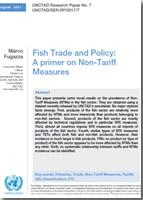
International trade is crucial to the fish sector especially in the least advanced economies. International trade can act as an employment creator, food supplier, income generator, and thus contributes to maintain food and nutrition security.
FAOs most recent report on the State of World Fisheries and Aquaculture (FAO, 2016) points to the fact that the sustained expansion of trade in fish and fishery products observed in recent decades has been fueled by growing fishery production and driven by high demand. As a consequence the fisheries sector has increasingly operated in a globalized environment and the tendency may further intensify. This may not have only positive consequences as over-capture and acceleration in stocks depletion have already reached worrying thresholds.
This paper presents some novel results on the prevalence of Non-Tariff Measures (NTMs) in the fish sector, using a dataset recently released by UNCTAD.
Although the reference country sample remains limited in terms of country coverage, countries included account for more than 80 percent of world fish trade. As a consequence the picture we obtain is a precise reflection of the types of NTMs implemented around the world and especially in major destination markets.
The paper also presents some descriptive statistics related to tariffs and offer some integrated view of two major policy instruments implemented in the fish sector. Subsidies are not part of the study due to limited data availability.
Six major stylized facts emerge:
-
Products of the fish sector are relatively more affected by NTMs and more intensively than products belonging to non-fish sectors.
-
Products of the fish sector are mostly affected by technical regulations and in particular SPS measures.
-
Almost all countries impose SPS measures on all imports of products of the fish sector.
-
Similar types of SPS measures and TBTs affect both fish and non-fish products. However, their incidence is much larger in fish products.
-
No product (or type of product) of the fish sector appears to be more affected by NTMs than any other.
-
No systematic relationship between tariffs and NTMs incidence can be identified.


